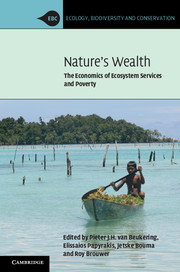Book contents
- Frontmatter
- Contents
- List of contributors
- Acknowledgements
- 1 The economics of ecosystem services and poverty
- Part I Biodiversity-related ecosystem services
- Part II Marine-related ecosystem services
- Part III Forest-related ecosystem services
- Part IV Water-related ecosystem services
- Part V Land-related ecosystem services
- 16 Income poverty and dependence on common resources in rural India
- 17 Tenure security and ecosystem service provisioning in Kenya
- 18 Pastureland degradation and poverty among herders in Mongolia
- 19 Changes in welfare and the environment in rural Uganda
- Index
- References
18 - Pastureland degradation and poverty among herders in Mongolia
Published online by Cambridge University Press: 05 July 2013
- Frontmatter
- Contents
- List of contributors
- Acknowledgements
- 1 The economics of ecosystem services and poverty
- Part I Biodiversity-related ecosystem services
- Part II Marine-related ecosystem services
- Part III Forest-related ecosystem services
- Part IV Water-related ecosystem services
- Part V Land-related ecosystem services
- 16 Income poverty and dependence on common resources in rural India
- 17 Tenure security and ecosystem service provisioning in Kenya
- 18 Pastureland degradation and poverty among herders in Mongolia
- 19 Changes in welfare and the environment in rural Uganda
- Index
- References
Summary
Introduction
After the collapse of communist rule in Mongolia in 1991, the demise of the livestock collectives resulted in private (household-based) livestock ownership and unclear range management institutions. Between 1991 and 1998 the livestock sector rapidly expanded, partly assisted by relatively good weather conditions, and partly by many new entrants in the livestock economy as a result of de-industrialization of the urban economy. In 1990 Mongolia had 25.9 million domesticated animals. In 1998 this number had grown to 32.9 million, an increase of 27%.
Between 1990 and 1998 the weather conditions were indeed rather favourable. Compared to the 1980s rainfall was higher, and winters were less severe (Batjargal et al. 2000). The carrying capacity of the Mongolian grazing lands improved, and the growing livestock population could, on average, be accommodated by these improved grazing conditions. However, changes in livestock mobility and range management styles, as well as unclear grazing institutions under privatized livestock regimes, already created carrying-capacity tensions in some areas. Where water wells were no longer maintained, some grazing areas were abandoned, resulting in condensed grazing in other areas.
- Type
- Chapter
- Information
- Nature's WealthThe Economics of Ecosystem Services and Poverty, pp. 373 - 390Publisher: Cambridge University PressPrint publication year: 2013



